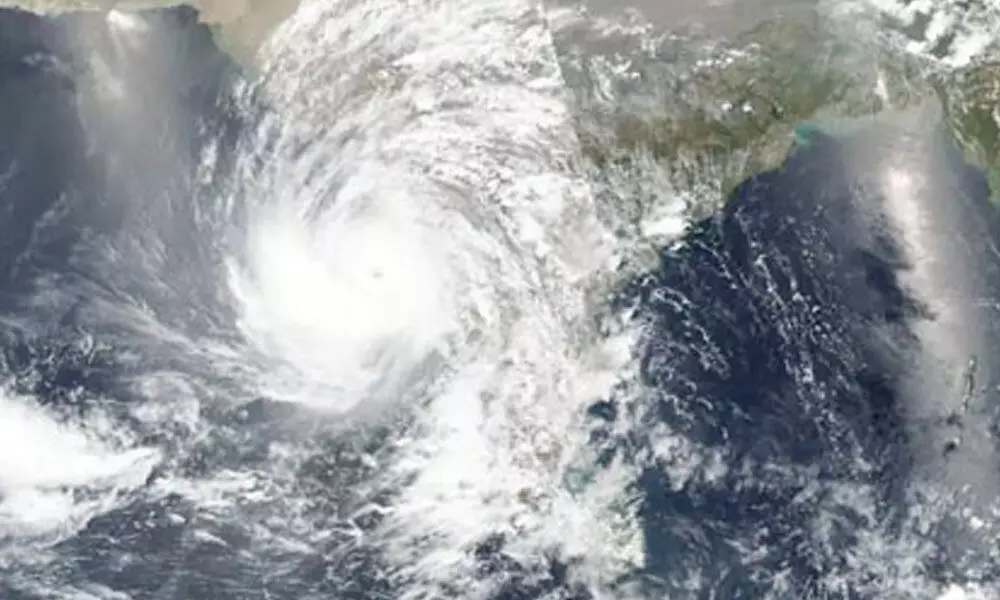Frequent and destructive cyclones are here to continue

Gulab Cyclone: AP and Odisha states alerted as cyclone heads to north coast
Global warming on account of greenhouse gases (GHG) emitted in the atmosphere continuously is the reason for heating the oceans, resulting in sea surges and cyclones
Global warming on account of greenhouse gases (GHG) emitted in the atmosphere continuously is the reason for heating the oceans, resulting in sea surges and cyclones. A week after cyclone 'Tauktae' had devastated all coastal States in the West coast region leaving a trail of destruction, cyclone 'Yaas' knocked at our doors on East coast.
The landfall of 'Tauktae' was in Gujarat which experienced a maximum devastation. Prime Minister Narendra Modi took up an aerial survey in Gujarat to assess the damage and was quick to announce a relief package of Rs 1000 crore for reconstruction there. Center and States of Odisha and West Bengal also enhanced their vigilance and preparedness like all States on West coast some days ago. West coast was devastated about a year ago by cyclone 'Nisarga' so was East coast by cyclone 'Amphan'. All the cyclones are marked by high velocity winds up to 175 km per hour and tidal waves of 4 to 6 meter high, inundating coastal areas for several days and leaving millions of evacuated families homeless on their return. Further agriculture lands are flooded by brackish water, which takes years to reclaim.
Experts have concluded that 'Tauktae' was the direct consequence of global warming and cyclogenesis. 90% of heat generated by GHG emissions since 1970 is absorbed by oceans. Arabian Sea and Bay of Bengal also warm up considerably. A climate scientist Matthew Roxy Koll at Indian Institute of tropical Metrology, Pune has said that normal sea temperature of these oceans in May remains as 28 to 290 Celsius, but when it crosses the threshold and goes up to 30-310 Celsius, rapid intensification into a storm is followed. Scientist also added that 'heat' is energy and cyclones also intensify rapidly by turning the potential energy stored in the ocean to kinetic energy. Kinetic energy leads to devastation in coastal areas followed by drop in ocean temperature. This is how potential energy stored in the ocean in the form of 'heat' is dissipated.
Global economies are pouring stimulus cash in fossil fuel based industries to recover from COVID-19 economic contraction; CO2 emission is bound to go up this year. Rise in pollution level post COVID will be comparable to massive increase in pollution during financial crisis 10 years ago. According to Paris climate accord of 2015, countries are to set goals (nationally determined contributions) (NDC) for themselves to bring reduction in pollution in this decade till 2030 by 45%, if global rise in temperature is to be capped at 1.50 Celsius by 2050. The world should therefore change its course, to avoid dangerous levels of heating and prevent frequent and more destructive climatic catastrophes like the cyclones and sea surges we are facing.
'Emission gap report' of United Nations Environment Program (UNEP) suggests that GHG emission is annually growing by 1.4% since 2010. However, the increase was 2.6% in 2019 because of forest fires in Brazil, Australia and California, thus registering the highest GHG emission of 59.1 Giga-ton of CO2 equivalent. The report has ranked starting from highest polluter China, followed by USA, European Union & UK and India; each of these contributed 14.1, 6.6, 4.3 and 3.7 Giga-ton respectively.
German watch with Climate Action Network has released Global Performance report 2020, where the biggest emitter China ranks 33rd, historical polluter USA at the bottom and India ranks 10th. G20 nations account for nearly 80% GHG emissions are not on track to meet Paris agreement and Australia, US and Canada are falling short of their targets.
Though India's performance is better than other members of G20, we have scope to do more to reduce our carbon foot print. We are committed to three major NDCs in Paris accord. Firstly, we pledged to cut down GHG emission by 33 to 35% by 2030, taking the base year of 2005. Secondly, we are committed to increase the share of non fossil based renewable electricity to 40% by 2030; and thirdly, we will enhance our forest cover by 2030 so as to absorb 2.5 to 3 Giga tones of CO2 annually.
India has taken action to achieve renewable energy target of 175 Giga Watts (GW) by 2022, and further 450 GW by 2030. Time and again our PM has highlighted climate resilient development practices, our partnership in International Solar Alliance and coalition for disaster resilient development practices. He has further made a commitment to a circular economy to focus on next generation Metro networks, waterways etc for convenience and efficiency as well as for cleaner environment. Among the largest clean energy drive globally, India is attempting to eliminate single use plastic, popularizing LED lights projected to save 38 million tones of CO2 annually and providing smoke free kitchen to 80 million households through 'Ujjawala' scheme. Projects like liquefied natural gas pipeline etc take us towards one nation one gas grid policy and our commitment of increasing the share of natural gas from present 6% to 15% by 2030. Country has also focused on ethanol production to increase its blending in patrol from present 5% to 20%. These are some very good steps to reduce CO2 emissions in our atmosphere.
Ahead of Glasgow climate summit in November 2021, US President Joe Biden held a virtual summit of 40 most polluting nations on 22nd April and urged for increasing mitigation targets. While USA, UK and European Nations have set quite ambitious targets of reducing CO2 equivalent, Australia and China have remained unmoved. China's contribution of 14.1 Giga-ton out of global 59.1 Giga-ton of CO2 equivalent is quite high and is a matter of concern. A few years ago China fixed 2060 for its net zero emission and before that pollution is hitting the peak in 2035. Chinese economy is fossil fuel dependent and as it stands now they will go on increasing the pollution till 2035, and thereafter it is projected to take downward trajectory to be net zero by 2060. China's annual GHG emission is equal to the sum total of emissions in US, European Union & UK and India. China will nullify the good efforts of these nations.
That means cyclones like Tauktae and Yaas will continue to hit the region with more frequency and will also be more destructive.
(The author is a former principal chief conservator of forests, Karnataka)




















